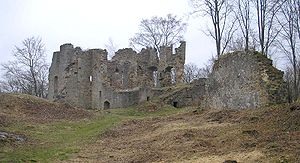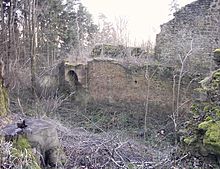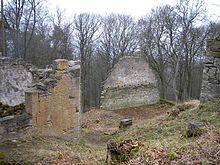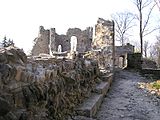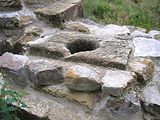Rauheneck Castle (Ebern)
| Rauheneck Castle | ||
|---|---|---|
|
The hall of the Rauheneck Castle |
||
| Creation time : | around 1180 | |
| Castle type : | Höhenburg, summit location | |
| Conservation status: | ruin | |
| Standing position : | Free nobles | |
| Place: | Vorbach (Ebern) | |
| Geographical location | 50 ° 6 '31.3 " N , 10 ° 43' 55.2" E | |
| Height: | 428 m above sea level NN | |
|
|
||
The castle Rauheneck (today common spelling Raueneck , "wooded corner, mountain spur ") is the ruin of an official castle of the diocese of Würzburg in the Haßberge in the district of Haßberge , Lower Franconia , Bavaria (Germany). The facility, which was in great need of renovation, was closed until 2006 due to the risk of collapse, but it has been possible to re-enter it since the beginning of the emergency safety system, which was not yet completed.
Geographical location
The ruins of the Höhenburg are located on a western foothill of the Haubeberg ( 428 m above sea level ), which is north of the village of Vorbach, a western part of the former district town of Ebern . It is surrounded by the mixed forest of the Haßberge Nature Park .
history
Castle

According to legend, Rauheneck Castle was built by the evicted Brambergers around 1180 after the neighboring Bramberg Castle was destroyed . The family then named themselves after their new castle. In 1231, the introduced noble Free Ludwig von Ruheneke together with half the castle and other real estate under the Lehn shoheit the Diocese of Würzburg . This was certainly not entirely voluntary. The von Rau (h) eneck family is said to have died out a short time later (around 1250).
The gentlemen von Rauheneck traceable in the written sources are referred to there as "nobiles" (noble free). A genealogical connection with the noble free von Bramberg can actually be assumed. Friedrich von Rauheneck occasionally used the nickname "von Bramberc". He stood in the dispute over the legacy of the Andechs-Meranians against the diocese of Bamberg (around 1248).
To protect the domination sex with numerous allied Lower nobility sfamilien around and gave his own holdings of his vassals on. Georg Ludwig Lehnes counted the lords of Lichtenstein , Kößeln, Gemeinfeld, Brünn, Hofheim, Ostheim, Scherschlitz, Kotzenwind (Kurzewind), Redwitz, Breitenbach, Westheim, Mehried, Holfeld, Neubrunn, Schoder and in his history of the Baunach-Grund in 1841/42 Lovers to follow the Rauenecker. The names of some of these servants prove that in the High Middle Ages there was a local aristocratic family in almost every place in the area. However, all of these clans died out over the centuries or reverted to the bourgeoisie or peasant class.
Possibly the rapprochement with the Hochstift Würzburg was a reaction to conflicts within the family. Because of a dispute with his nephew Friedrich Ludwig sported of Rauheneck his property to the diocese in 1244 for a second time to feud on. To compensate, he was used as a Burgmann on Rauheneck.
After the Lords of Rauheneck died out, the bishopric occupied the castle with bailiffs and castle men . In 1300 Konrad Staudigel held this office. In 1304 a Wolvelin (probably a stone from Altenstein ) appeared as an official. In 1338 Heinrich von Sternberg can be traced as an hereditary castle man on Rauheneck. In the same year, Albrecht von Aufseß also paid homage to Rauheneck as hereditary castle man.
In 1341 Heinrich von Wiesen sat on the fortress , in 1346 Hans Truchseß von Birkach. In 1364 Apel Fuchs was mentioned in a document. Before 1378 Gecke of Füllbach was bailiff to Rauheneck.
In the 14th and 15th centuries, the Marschalk von Rau (h) eneck sat at the castle as Würzburg servants . In 1378 Dietz Marschalk was the first of his line to appear on the fortress. Dietz invested 280 guilders in the expansion of his official castle, which he would later get back from the bishopric. He also had to deposit 120 guilders for the castle property. Since he took office, the castle property has been associated with the officials.
Until 1379 the Kemmerer lived as Ganerben at the castle. Apel Dietrich and Bernhard Kemmerer finally sold their shares to the Marschalk family. In 1430, in view of the threat posed by the Hussites , the Marschalk invested another 200 guilders in the modernization of the fortress.
1445 enfeoffed the bishopric Wilhelm Marschalk again with Rauheneck. Heinz Marschalk returned the fiefdom to Würzburg in 1476. At that time the castle was pledged and was redeemed by the bishopric with hard cash. After the release of the deposit, the offices of Ebern, Seßlach , Bramberg and Rauheneck were gradually merged . Christoph Fuchs, previously the bailiff for Ebern and Seßlach, now also administered the Rauheneck department.
In 1483 the rule was pledged again for 1,000 guilders. After Hartung von Bibra had raised the pledge for the bishopric in 1486, the castle was assigned to him as his seat. He had to undertake to keep three sticks (soldiers) and their horses ready at all times.
After the Marschalk family died out with Friedrich Marschalk in 1550, the castle finally fell back to the diocese of Würzburg. During the Thirty Years' War the office was used as an advertising space for twelve companies of infantry. In 1633/34, two equestrian associations camped at the castle, which was then under Swedish administration. A little later, the Swedish bailiff Lorenz Scheffer had to give way again to the Catholic Würzburg bailiffs.
As the official seat of Würzburg, the complex was maintained until the end of the 17th century and was abandoned in 1720. The dual office of Bramberg-Rauheneck in Würzburg was moved to the nearby town of Ebern in 1685. Both offices had already been combined in 1560. As the last bailiff, Liborius Friedrich von Hausstein vacated the lonely hilltop castle and moved into the new official seat in the city.
The Freiherren von Rotenhan have owned the castle complex since 1829 , and it has fallen into disrepair almost unhindered since then. Emergency security of the castle only started in July 2006 after the Haßberge district was able to lease the area for the next few decades. As a preparatory measure, an archaeological excavation took place under the direction of a medieval archaeologist .
chapel
A chapel in the castle was mentioned as early as 1232 , which was incorporated into the parish of Ebern. There is evidence of a chaplain for 1428 . The population of the surrounding villages Jesserndorf and Bischwind attended the church service there and had to pay the Ebern pastor five pounds Heller annually as compensation (1435). The church was dedicated to St. John the Baptist and was already in the castle's kennel. In 1436 the Würzburg bishop allowed the construction of a cemetery.
The church was used until 1745 after the castle was cleared. However, the rectory had already been abandoned in 1615.
Originally, the chapel was apparently on the ground floor of the palace next to the later gatekeepers exchange. A narrow pointed arch window has been preserved there in the outer wall. It is possible that the first floor served as a prayer room even after the new chapel was built . Two consecration crosses can still be seen on the plaster residue of the arched passage to the small guard room .
The millers from Raueneck
1842, appeared in Wuerzburg history of Baunach-ground in Lower Franconia in the self-published by the author Georg Ludwig Lehne. He took the widespread view that the Marschalke von Raueneck family had died out in 1550.
On August 1, 1842, a G. K. W. Müller von Raueneck in Schleusingen published a "correction" of this opinion. He claimed to be a descendant of this sex. Allegedly a Georg von Raueneck lost his property as a result of family disputes and therefore entered the imperial army service around 1508. His wife, née von Lichtenstein , is said to have died shortly before. The nobleman had therefore given his four-year-old son Friedrich to the childless Müller von Frickendorf for upbringing. This later made the Rauenecker heir, but demanded that the family should henceforth be called Müller zu Raueneck. The Rauenecker are also of a tribe with the Austrian Rauhenecker. Lehnes, however, assumed a genealogical connection between the family and the Lords of Rotenhan.
This "correction" was added without comment to the reprint of the history of the Baunach reason published in 2005 . In fact, the name Müller von Raueneck appears in some aristocratic lists and registers up to the present day, but it no longer seems to be listed in Germany today. The author of the "correction" even added a master list of Müller von Raueneck and unspecified "certificate extracts" to his statements.
The information given by the mysterious G. K. W Müller von Raueneck has not yet been seriously checked by specialist science. It is still unclear whether it is not a joke, perhaps from the academic environment. Lehnes was just a simple archival writer without academic training, i.e. a formerly committed local history researcher whose work was possibly to be denigrated in this way.
description
Parts of the impressive Hussite period kennels with two round towers and a shooting bay , the ruins of the palas and the late Gothic castle chapel as well as two cellar vaults have been preserved .
Today you enter the facility on the east side over a stone arch bridge from the 16th / 17th century. Century. This bridge became necessary after the main entrance had been relocated next to the Palas and had to cross the neck ditch in front of the kennels. A previously clogged gate has been preserved to the right on the ground floor of the hall. The original main gate could have been in the gap in the wall in front of the chapel on the other side of the castle (reconstruction by Zeune ).
When the bridge was built, one of the Zwinger's two gun bay was largely removed. The surviving bay window is acutely endangered, the left part has collapsed for decades.
On the right rise the ruins of the emergency hall (13th to 16th centuries). The huge Renaissance - window of the upper floor will be serious historical monument generic problems. One of the windows was underpinned with a steel beam. Interesting is a small chimney in the tiny chamber next to the bridge. It should have been the gatekeeper's room. Only the remains of the walls and cellar vaults have survived from the rest of the interior development.
Whether the castle ever a dungeon has owned, could not be found. Some castle researchers are considering a dump of rubble west of the palace as a possible location for such a main tower . A strongly stylized illustration on a map from 1665 shows a tower with a gable roof next to the chapel . This illustration is seen as evidence of the keep of the castle in the Web project Burgen in Bayern of the House of Bavarian History . However, the schematic representation certainly does not allow any conclusions to be drawn about the actual existence of such a building. Until a professional archaeological investigation of the presumed tower location has been carried out, all relevant considerations must remain speculative. However, when Dietz Marschalk took office in 1378, he had to undertake to reward the tower keeper and the goalkeeper.
The ruins of the late Gothic former castle chapel, which protrudes like a bastion into the ditch, are remarkable . There are still plaster residues with the original consecration crosses. The chapel in particular is severely affected by increasing vandalism on the ruins. At the beginning of 2005, part of the beautiful coffin cornice on the outside was thrown into the moat. Some structural damage results from a faulty attempt at restoring the wall crowns at the end of the 20th century by a youth group. Around 1980 a human skeleton was uncovered in a robbery excavation in the chapel , which indicates a crypt or burial place under the church.
Two round towers, a long piece of the kennel wall to the left of the chapel and then a tower-like protrusion interpreted as a cistern can still be seen from the kennel facility on the valley side .
A large outer bailey was located below the main castle . The gable wall of a large barn- like building still stands there . In 2008 this part of the castle could also be secured in an emergency. In the area there are further remains of walls, rock workings and a stone well trough. Higher up is the entrance to a spacious, artificially enlarged cave that was obviously used as a cellar.
To the northeast of the castle, a mighty rock shows clear traces of human work. A rectangular recess is carved on the top, possibly another cistern. Next door, a memorial stone commemorates the unsolved murder of a berry hunter at the beginning of the 20th century. The quarry that can be seen behind it should have supplied the stone for the construction of the castle as early as the Middle Ages.
The entire castle complex was built from the sandstone there. Numerous beautiful architectural parts lie unnoticed and moss overgrown on the forest floor .
The facility is in great danger of collapsing, but the emergency safety measures began in the summer of 2006. The decline is accelerated by a lively esoteric and occult tourism .
The castle is a stop on the castle history trail of the Haßberge district.
The castle saga
What is striking is the correspondence between the castle saga of a buried treasure that can only be lifted by a Sunday child and the almost identical castle saga of the Rauheneck Castle near Baden in Lower Austria . In both traditions, the treasure is guarded by a restless spirit. The treasure hunter must have been rocked in a cradle that was made from the wood of a cherry tree that grew on the top of the castle wall. Ludwig Bechstein already noted the correspondence between the two legends in his German Book of Legends from 1853 ( Das Kirschbäumchen at Raueneck Castle , no. 827). It is possible that the legend was transferred to Franconia from the better-known Rauheneck Castle in the Vienna Woods in the early 19th century because the names were identical .
Emergency backup
In the course of the archaeological excavation, some pits created by robbery excavations were filled and part of the high medieval wall of the inner castle was exposed. Here a remnant of a floor covering made of stone slabs and a step came to light. The Abort opening is seated in the wall of the partially channel led obtained before the establishment of the kennel in the trench.
The subsequent emergency backup has not yet been completed. Further conservation measures were carried out on the Palas by the end of 2006. Here the gaping hole in the cellar vault could also be closed ( brick lining). One of the renaissance double windows, which was in acute danger of collapsing, received a supporting inner frame made of steel.
The masonry of the exposed curtain wall with its Opus spicatum filling has already been secured, as has the crowns of the chapel. The recently lost architectural details (chapel and hall, transverse wall to the castle courtyard) are apparently not being reconstructed.
documentation
The Rauheneck castle ruins shortly before and during the emergency security in 2006 and 2007.
literature
- Georg Ludwig Lehnes: History of the Baunach reason in Lower Franconia. Würzburg 1842, reprint Neustadt an der Aisch 2005, ISBN 3-89557-251-9 .
- The art monuments of the Kingdom of Bavaria, XV, District Office Ebern. Munich 1916, pp. 177-182.
- Isolde Maierhöfer: Ebern in the Historical Atlas of Bavaria, part of Franconia, issue 15 . Munich, Commission for Bavarian National History, 1964.
- Joachim Zeune : Castles in Eberner Land in Eberner Heimatblätter , 2 booklets. Boars 2003.
Web links
- Raueneck castle ruins on the homepage of the House of Bavarian History (plans, history, building history, existing buildings)
- Reconstruction drawing by Wolfgang Braun
